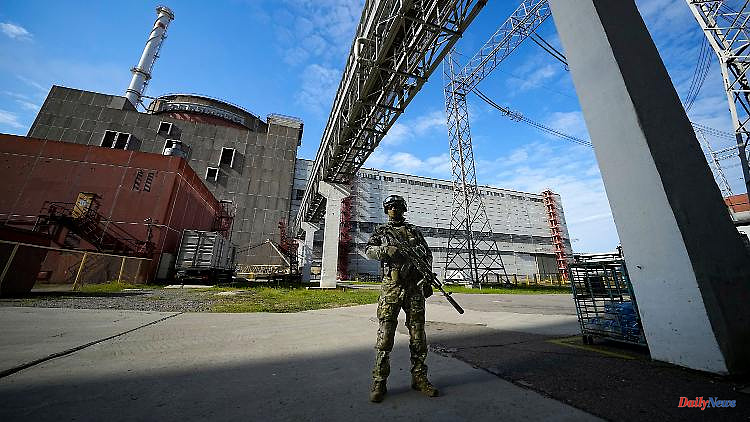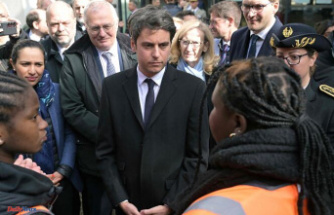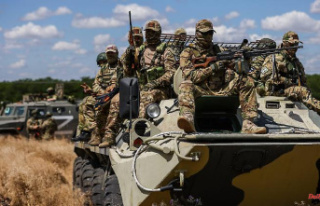The Zaporizhia nuclear power plant, occupied by Russian troops, seems like a ticking time bomb; the plant has been under fire for weeks. A team of experts is now traveling to the dangerous area to inspect damage and get an idea of the situation. In an interview with ntv.de, expert Anna Veronika Wendland explains what can be expected from the IAEA mission and how close Europe is to another nuclear catastrophe.
ntv.de: The Ukrainian nuclear power plant Zaporizhia, occupied by Russian troops, is the largest in Europe. It has been under fire for weeks and the situation looks threatening. Two reactors went into emergency shutdown last week because the power supply was intermittent. How big is the risk of a nuclear accident from the fighting?
Anna Veronika Wendland: You have to differentiate there. It was a reactor scram, that's right. This happens, for example, when limit values of the reactor protection system are exceeded. However, according to the operator of the nuclear power plant, the system was not completely isolated from the external power supply. It was still powered by a line, meaning it was not yet powered by emergency power. This only happens when all network connections are cut. Then the emergency generators have to take over the supply.
What can happen if the power grid connection is completely lost?
Then there is an emergency power failure. When the plant rushes into this emergency power situation from full load, it looks very dramatic, because the pressure and temperature in the reactor system have to be reduced at a faster pace. Then live steam is blown off over the roof. After that, the pressure is so low that the aftercooling pumps can take over, which draw significantly less power than the large main coolant and feed water pumps, which would initially continue to run during a regular shutdown. In the event of emergency power, the power required for the after-cooling chain is produced by emergency power generators. Each of the six blocks in Zaporizhia has three diesel generators available for this purpose. However, one is enough to organize the post-cooling of the block.
It sounds like a lot has to happen before a nuclear catastrophe occurs. Or is that giving the wrong impression?
This assessment is always a tightrope walk. First you have to name things as they are. Technically, Zaporizhschja was never on the verge of super meltdown, as some claim. At the same time, one should not downplay the situation. The whole condition of the plant, the occupation by Russian soldiers who store war equipment on the premises, who shoot at the Ukrainians from there and, according to a human rights organization, even torture employees of the nuclear power plant and spread terror, is completely untenable. Just having staff working under such pressure means that mistakes could happen. However, it is important to note that there are still many barriers between a power failure and a core meltdown.
How well are the reactors protected from a meltdown?
In principle, there are multi-level security measures in Zaporizhia. It is quite robust, also in terms of the emergency power supply. But even if ancillary systems that are important for the power plant operation are shelled, as was the case, for example, when one of the two nitrogen-oxygen stations was damaged by shelling, this is always an impairment. These are all systems that are needed to ensure regular reactor operation or the orderly shutdown of the plant to after-cooling operation. With two or three random hits, not so much happens. It becomes dangerous when several factors come together or the reactors are deliberately under constant fire. They don't last long.
Wouldn't it then be safer to switch off the system to protect it from attacks?
The operating company Energoatom also did this to some extent. At least units one and two out of a total of six units have been placed on long-term standstill. Of the other four blocks, we see two running - presumably to keep the power grid from collapsing. If that were to happen, the nuclear power plant would also have an emergency power problem. I suspect they keep the plants running to maintain power stability. If this dependency did not exist, it would be safer to switch off the systems.
Why?
Valuable time is gained with a precautionary reactor shutdown, because the more time elapses after shutdown, the lower the decay heat that has to be dissipated from the reactor core. It is very high immediately after the shutdown and then drops rapidly. This gives you an extension of the time before a core meltdown would occur if all aftercooling systems failed.
What would be the worst thing that could happen in Zaporizhia?
The worst scenario that seems realistic is the power cut. If all three emergency diesel generators in one block failed and the units in the neighboring blocks were unable to help out, or if the emergency diesel generators ran out of fuel, we would have a scenario like that in Fukushima at the end of this chain of events. In Fukushima, the emergency power supply failed because diesel generators and switchgear were flooded by a tsunami. There was a total power failure and the systems could no longer be cooled. So if everything fails in the end, we have a Fukushima case.
What would that mean for Europe?
Germany and Western Europe would have nothing serious to fear. We were able to observe the maximum that would threaten us very well after Chernobyl. If there is a Fukushima case, a lot depends on the weather conditions. There is the question of how quickly and where the radioactive substances are distributed. It is only ever catastrophic for the people in the immediate vicinity of the plants. We know from Fukushima that people had to be evacuated within a radius of 20 to 40 kilometers.
What would be bad or good weather?
Bad weather conditions are always when it rains during the release. Then the radionuclides are washed out of the air and fall in concentrated form in the immediate vicinity of the plant. Then the people in the immediate vicinity have a real problem, because then there is a high level of contamination, especially from radioactive isotopes of cesium, strontium and iodine. This can be seen well in the case of Chernobyl: Cesium-137 soil pollution maps show that the contamination is often patchy, which has to do with the rainfall in the aftermath of the accident. The wind direction also has a strong influence on the direction in which the radiation is distributed. So it makes a difference whether it is windy, sunny weather or whether there is constant rain. However, the latter is rare in Zaporizhia at this time of year.
A team of experts from the International Atomic Energy Agency (IAEA) is on its way to Zaporizhia. What does this visit mean and what will the experts do there?
The visit is a very positive sign. The mere fact that international players are on site is already a protection for the plant. Then it depends on whether the experts are able to inspect all six blocks and get access to the relevant facilities. Normally this is discussed with the operating company, but now the Russian occupiers have the last word. This could severely restrict not only the freedom of movement, but also the freedom of speech of the inspectors.
How are such inspections usually carried out?
That always depends on the goal of the inspection. In this case, the mission is to determine the current condition of the facility and what damage has been caused. In order to be able to fulfill their mission, the experts must be able to move freely around the facility and go to places where there have been shell impacts, for example. The damage must then be logged, photographed and assessed. It is important to find out whether the damaged systems are still functional. That would be the normal course. Discussions with the workforce in a protected space would also be very important, so that the members of the operating shifts can speak freely. I fear that the Russians will hinder that.
Approximately how long will that take?
We do not know that, yet. It is a huge power plant and the impacts are widely separated in area. If you assume that a group of about ten inspectors will come, it would actually take two weeks to take a close look at what happened and to talk to the employees. After that, the usual thing would be for the IAEA to write a report and analyze the results. There will probably also be a press conference. Then it will be seen to what extent the inspectors were able to find out something.
Who is taking care of the security of the IAEA staff during these two weeks?
This is a logistical and military challenge. The question is in which direction the inspectors will enter and how the warring parties will come to an agreement. According to reports, this is now happening from Ukrainian-controlled territory. This is important for the Ukrainians because arriving via Moscow could be understood as indirect recognition of the IAEA occupation. The respective side through whose controlled territory the inspectors enter is responsible for their security. Of course, this is extremely dangerous, because the front line runs in this area and there is shelling. In terms of security requirements, this is similar to the trip of high-ranking politicians to Kyiv in the spring, which was accompanied by the constant threat of rocket attacks.
Vivian Micks spoke to Anna Veronika Wendland.












